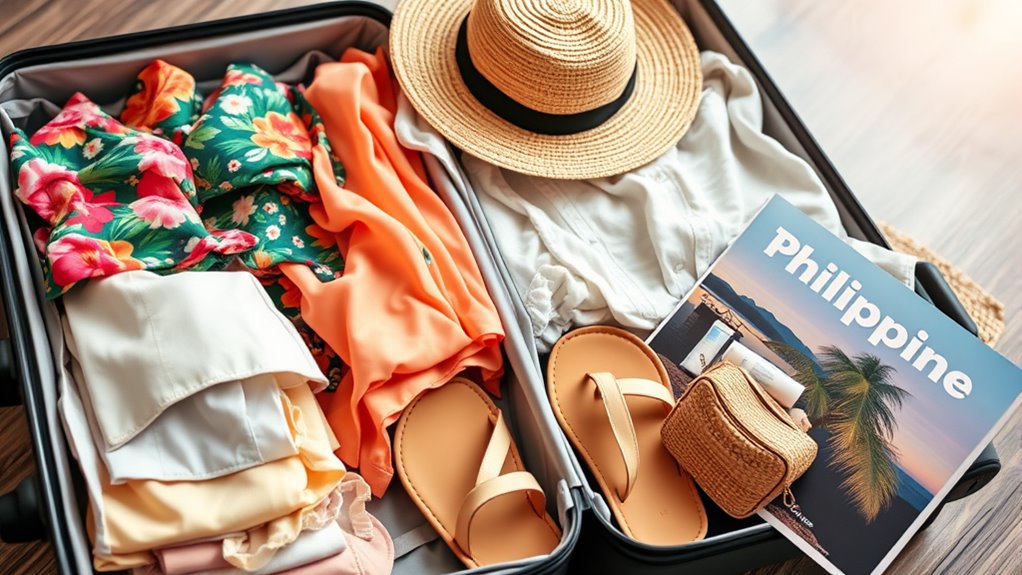When visiting your Filipina partner, pack lightweight clothing like cotton shirts and breathable shorts for the warm weather. Don’t forget comfortable footwear for various activities and formal attire for special occasions. Essential toiletries, a portable charger, and an international adapter are must-haves. Familiarize yourself with local customs to show respect and enhance your experience. If you’re curious about specific packing strategies and must-know tips, there’s much more to explore!
Key Takeaways
- Pack lightweight clothing such as cotton shirts and shorts to stay comfortable in the warm climate of the Philippines.
- Include formal attire and gifts to honor family gatherings and special occasions with your Filipina partner.
- Bring travel-sized toiletries and personal hygiene items for convenience and to maintain freshness during your stay.
- Don’t forget a portable power bank and international travel adapter to keep your devices charged and connected.
- Learn basic Filipino phrases to enhance communication and show respect for local culture during your visit.
Essential Clothing for Warm Weather

When you’re heading to the Philippines, packing essential clothing for warm weather is crucial for your comfort.
Lightweight tops like T-shirts, tank tops, and vest tops are perfect for keeping cool. Opt for shorts or loose cotton trousers for versatility in the heat. Flowing dresses and jumpsuits also work great for humid days.
Lightweight tops, shorts, and flowing dresses are essential for staying cool and comfortable in the Philippine heat.
Choose moisture-wicking fabrics to keep sweat at bay and consider lightweight long sleeves for sun protection. Remember, breathable fabrics like cotton and linen enhance comfort, while loose-fitting clothing allows for airflow.
It’s wise to pack a few layers for changing conditions, especially in cooler areas at night. Quick-drying materials are a must for unexpected rain, ensuring you stay comfortable throughout your trip.
Footwear Choices for Various Activities
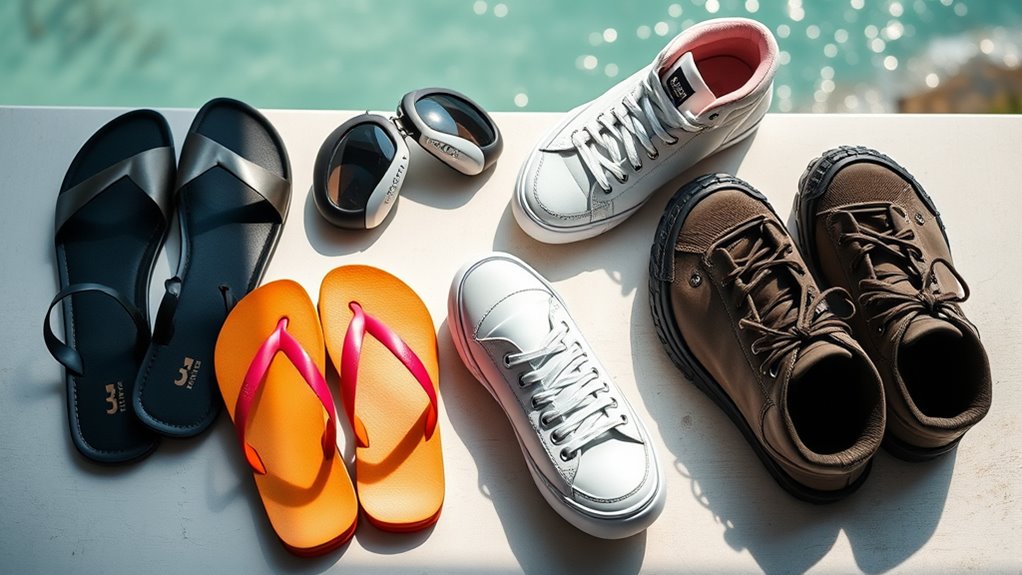
Choosing the right footwear can make all the difference in your trip to the Philippines, especially since you’ll likely engage in various activities.
For casual outings and daily walks, pack comfortable sneakers or loafers that can easily shift from day to night. Sandals or flip-flops are perfect for warm weather and casual settings, especially at the beach. Incorporating activities like walking for weight loss can enhance your overall experience and fitness during your travels.
If adventure calls, don’t forget sturdy hiking boots for trekking or trail runners for fast-paced hikes.
For formal occasions, bring along dress shoes or elegant heels that fit the dress code.
Finally, if you plan to explore water activities, water shoes or Crocs will keep your feet protected and comfortable.
Prioritize versatility and comfort to guarantee a fantastic experience! Additionally, consider the importance of long-term financial planning for your trip to ensure you can enjoy all the activities without stress.
Toiletries and Personal Hygiene Items
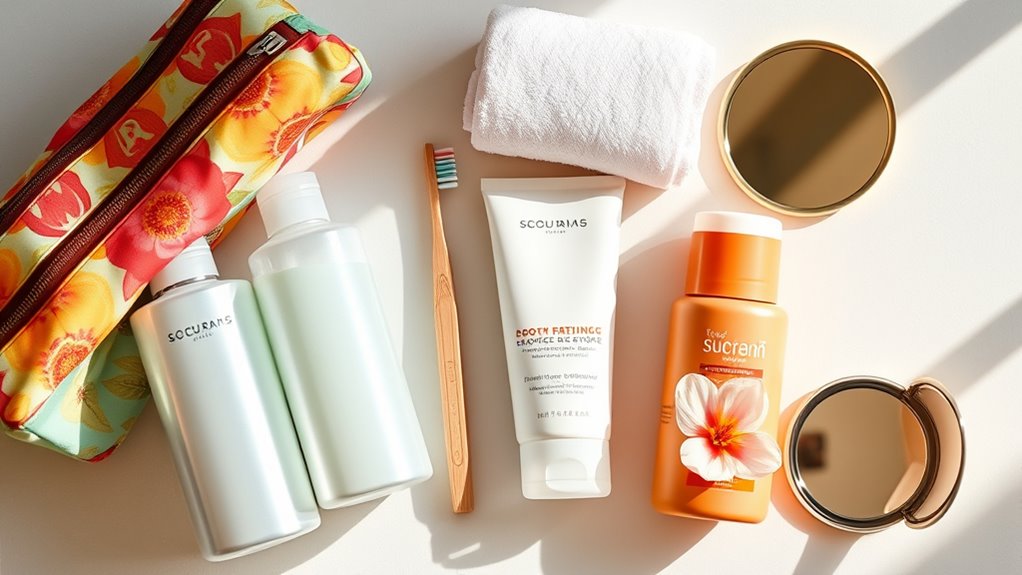
Packing the right toiletries and personal hygiene items is essential for a comfortable stay in the Philippines, especially given the humid climate.
Bring heavy-duty deodorant to stay fresh throughout the day. Don’t forget portable packs of tissues and toilet paper, as they mightn’t always be available in public restrooms.
Use Tupperware or similar containers to prevent leaks and keep your items organized. Pack your preferred feminine hygiene products, and consider including dryer sheets to avoid static cling in your clothes.
Essentials like toothbrushes, toothpaste, shampoo, conditioner, and body wash should also be included. Travel-sized items save space, while eco-friendly and biodegradable products help protect the environment.
Finally, pack hand sanitizer and a basic first aid kit for added peace of mind.
Must-Have Electronics and Gadgets

As you prepare for your trip to the Philippines, having the right electronics and gadgets can make your experience smoother and more enjoyable.
Start with a newer smartphone for easy communication and navigation. A portable power bank guarantees your devices stay charged while you explore. Don’t forget an international travel adapter and a power converter to keep your electronics safe and functional.
Consider bringing an Airalo eSIM for hassle-free data access. A GlocalMe mobile hotspot can provide secure Wi-Fi wherever you go.
Noise-canceling headphones help during long flights, while a universal charging cable reduces clutter.
Finally, an electronics organizer keeps everything tidy, making sure you’re ready for any adventure that comes your way.
Understanding Local Culture and Etiquette
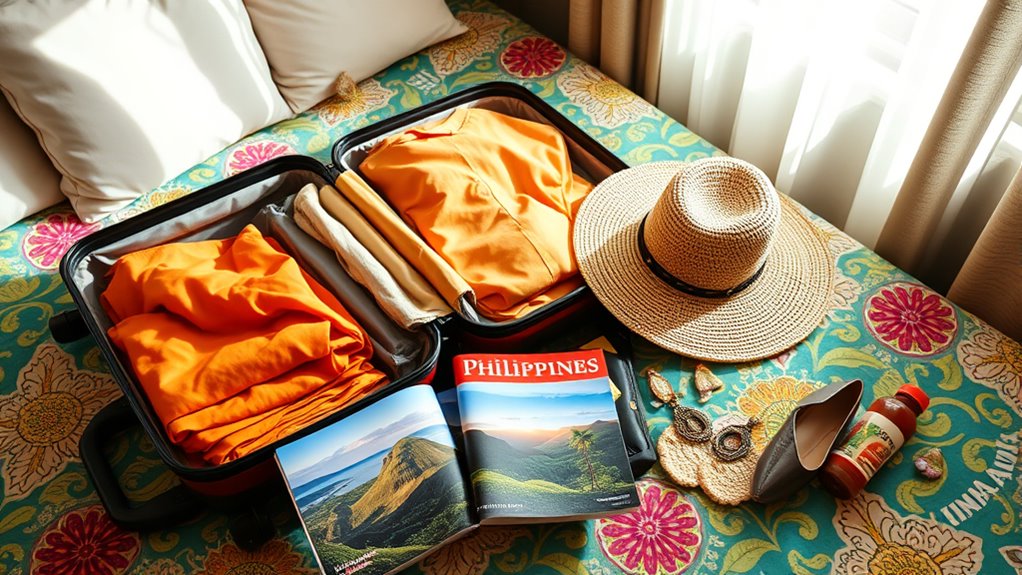
Understanding local culture and etiquette is essential for a fulfilling visit to the Philippines, especially when connecting with your Filipina partner.
Understanding Filipino culture and etiquette is key to enriching your experience and deepening your connection with your Filipina partner.
Dress modestly, particularly in religious or rural areas, and always show respect for elders by using polite forms like “po” and “opo.” Humility is valued, so avoid boasting.
While punctuality is relaxed, aim to be on time for formal events. Filipinos are incredibly hospitable; accept offered refreshments as declining them can seem rude.
When dining, try a variety of dishes and remember to use a spoon and fork, though hands are acceptable in some contexts.
Finally, learn a few local phrases like “salamat” to express gratitude and connect with the culture.
Important Travel and Safety Precautions

When planning your trip to the Philippines, it’s essential to prioritize important travel and safety precautions to guarantee a smooth experience.
Start by researching your destinations to understand local attractions and geography. Book your transportation and accommodations early for the best rates, and stay updated on health advisories, especially regarding malaria.
Use licensed taxis or public transport and arrange rides through apps like Grab for added safety. Always carry your identification and a basic emergency kit, and avoid sharing rides with strangers.
Stay informed about local news and keep a list of emergency contacts handy. Finally, don’t forget to have adequate travel insurance and know the locations of nearby medical facilities for any health concerns. Additionally, consider establishing clear rules with your Filipina partner to ensure a respectful and enjoyable visit for both of you.
Packing Efficiently With Packing Cubes
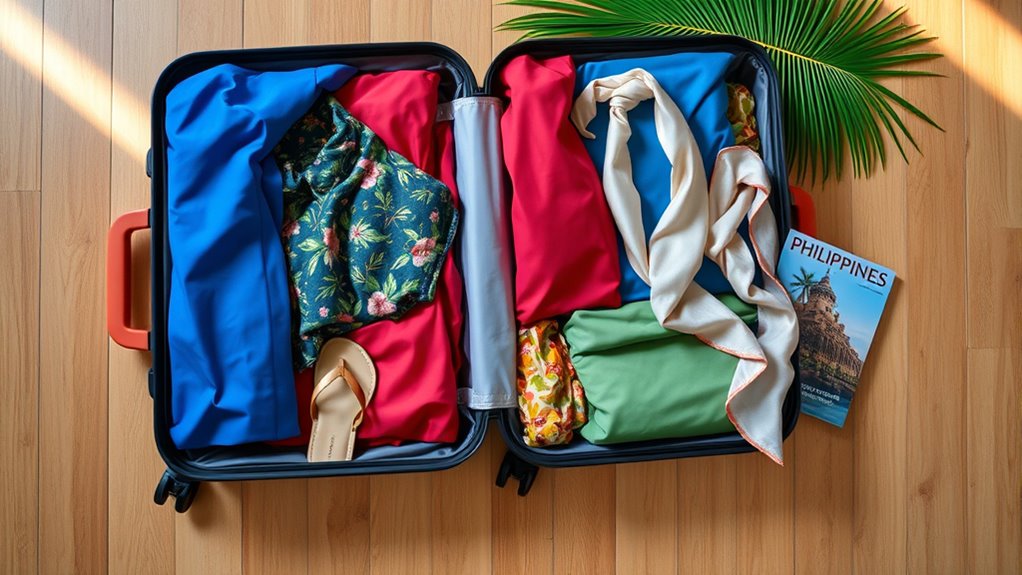
Packing efficiently with packing cubes can transform your travel experience, making it easier to stay organized and find what you need on the go.
These cubes let you categorize your belongings, so you won’t have to rummage through your suitcase for that favorite shirt. They maximize space, ensuring you fit more items while keeping everything tidy. Plus, they protect your clothes from spills and wrinkles.
For trips to tropical destinations like the Philippines, pack lightweight clothing in specific cubes, and consider using separate cubes for daily outfits, toiletries, and tech gear. Utilizing lightweight designs for packing can further enhance your travel efficiency.
With packing cubes, you’ll have quick access to essentials, streamline your packing process, and maintain organization throughout your journey.
Health and Safety Essentials

Traveling to the Philippines requires attention to health and safety essentials, especially since you’ll want to fully enjoy your time with your Filipina partner.
Start by getting recommended vaccinations, like Hepatitis A and Typhoid, to protect yourself from food and waterborne diseases. If you’re visiting certain regions, consult your healthcare provider about malaria prevention.
Getting vaccinated for Hepatitis A and Typhoid is essential for protecting against food and waterborne diseases while traveling.
Pack insect repellent to guard against mosquito-borne illnesses like dengue. Always drink bottled or filtered water and maintain good hygiene practices.
Be aware of your surroundings to avoid petty crime and stay in well-lit areas at night. Finally, prepare a basic first aid kit and keep local healthcare contacts handy for emergencies.
Prioritizing these essentials will help guarantee a safe and enjoyable trip.
Navigating Transportation and Traffic

Although maneuvering transportation and traffic in the Philippines can seem intimidating, understanding your options will make the experience much smoother.
You can hop on a jeepney for an authentic local experience or use tricycles for short trips in smaller towns. Taxis are readily available in urban centers like Manila, while ride-hailing services like Uber and Grab offer convenience.
If you’re traveling between cities, consider the MRT or LRT for faster commutes. Don’t forget about domestic flights for inter-island travel; just remember to book in advance.
Be prepared for heavy traffic, especially during rush hours, and always allow extra time for delays. Using GPS can help you find alternative routes to avoid congestion.
Preparing for Special Occasions

When preparing for special occasions in the Philippines, immersing yourself in local customs can greatly enhance your experience.
Familiarize yourself with the significance of family gatherings, as they often involve extensive planning and heartfelt connections. Learn a few basic phrases in Filipino to spark conversations and show respect.
Be open to trying diverse Filipino dishes like pancit and lechon, as food plays a central role in celebrations. Understanding family dynamics will help you navigate social interactions smoothly.
Dress appropriately for formal events, and remember to bring gifts as a gesture of goodwill. Additionally, embracing the concept of empowering families in caregiving can help you appreciate the deep connections that underpin these joyous occasions.
Finally, embrace the lively spirit of music and dance to fully participate in the joyous atmosphere. Your adaptability will make these occasions unforgettable.
Frequently Asked Questions
What Gifts Should I Bring for My Filipina Partner’s Family?
When you’re thinking about gifts for your Filipina partner’s family, consider cultural items like traditional handcrafted pieces or local snacks such as dried mangoes.
High-end toiletries, jewelry, or unique food items can also leave a lasting impression.
For extended family, practical gifts like a rice cooker or shared snacks are appreciated.
Always remember to respect their traditions and preferences, as thoughtful gifts can strengthen your connection with them.
How Can I Manage Cultural Differences During My Visit?
How can you gracefully navigate cultural differences during your visit?
Start by embracing the warmth and hospitality of your hosts. Show respect by using titles for elders and learning a few Filipino phrases.
Be open to sharing meals and participating in local customs. Remember, maintaining harmony is key, so avoid confrontations.
Finally, adapt to their relaxed approach to time and enjoy the rich cultural experience that awaits you!
What Should I Know About Local Dining Customs?
When you experience local dining customs, you’ll notice meals are often communal, fostering social bonds.
Be prepared to eat with your right hand, especially if you try Kamayan. It’s respectful to let elders eat first and to say “kain tayo” before starting.
Sharing dishes is the norm, but avoid taking the last serving.
Remember to pace yourself; enjoying the meal is just as important as the food itself in Filipino culture.
Are There Specific Local Festivals I Should Plan Around?
Imagine walking through a vibrant garden, each festival a unique flower blooming in its season.
You’ll want to plan your visit around local celebrations like the Pahiyas Festival in May, where colors burst forth, or the Sinulog Festival in January, with its lively dances.
Don’t miss the Ati-Atihan in January, either! Each event offers a chance to embrace local culture and connect deeply with the community, making your journey unforgettable.
How Do I Communicate Effectively With My Partner’s Family?
To communicate effectively with your partner’s family, start by learning a few key phrases in Tagalog—it shows effort and respect.
Be mindful of your tone and body language, as nonverbal cues carry weight. Always address elders respectfully and participate in family activities to build rapport.
Embrace the indirect communication style to maintain harmony, and don’t hesitate to express gratitude.
Keeping an open mind will help you navigate cultural nuances smoothly.
Conclusion
As you prepare for your journey to meet your Filipina partner, think of your suitcase as a treasure chest. Each item you pack is a gem, shining with thoughtfulness and care. By choosing the right clothes, gadgets, and essentials, you’re not just filling a bag; you’re crafting an experience that reflects your love and respect for her culture. With every careful selection, you’re building a bridge, connecting your worlds with understanding and warmth. Now, let the adventure begin!
